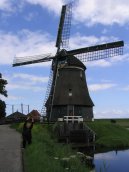| Introduction - Netherlands: |
| Location - Netherlands: |
| People - Netherlands: |
| Government - Netherlands: |
| Economy - Netherlands: |
Economy overview | The Netherlands has a prosperous and open economy, which depends heavily on foreign trade. The economy is noted for stable industrial relations, moderate unemployment and inflation, a sizable current account surplus, and an important role as a European transportation hub. Industrial activity is predominantly in food processing, chemicals, petroleum refining, and electrical machinery. A highly mechanized agricultural sector employs no more than 2% of the labor force but provides large surpluses for the food-processing industry and for exports. The Netherlands, along with 11 of its EU partners, began circulating the euro currency on 1 January 2002. The country continues to be one of the leading European nations for attracting foreign direct investment. Economic growth slowed considerably in 2001-06, as part of the global economic slowdown, but for the four years before that, annual growth averaged nearly 4%, well above the EU average. |
|
Gdp purchasing power parity | $529.1 billion (2006 est.) |
|
Gdp official exchange rate | $612.7 billion (2006 est.) |
|
Gdp real growth rate | 2.9% (2006 est.) |
|
Gdp per capita ppp | $32,100 (2006 est.) |
|
Gdp composition by sector | agriculture: 2.1%
industry: 23.9%
services: 73.9% (2006 est.) |
|
Labor force | 7.6 million (2006 est.) |
|
Labor force by occupation | agriculture: 2%
industry: 19%
services: 79% (2004 est.) |
|
Unemployment rate | 5.5% (2006 est.) |
|
Population below poverty line | 10.5% (1999) |
|
Household income or consumption by percentage share | lowest 10%: 2.5%
highest 10%: 22.9% (1999) |
|
Distribution of family income gini index | 30.9 (2005) |
|
Inflation rate consumer prices | 1.4% (2006 est.) |
|
Investment gross fixed | 19.3% of GDP (2006 est.) |
|
Budget | revenues: $304.3 billion
expenditures: $306.5 billion; including capital expenditures of $NA (2006 est.) |
|
Public debt | 50.8% of GDP (2006 est.) |
|
Agriculture products | grains, potatoes, sugar beets, fruits, vegetables; livestock |
|
Industries | agroindustries, metal and engineering products, electrical machinery and equipment, chemicals, petroleum, construction, microelectronics, fishing |
|
Industrial production growth rate | 2.3% (2006 est.) |
|
Electricity production | 92.7 billion kWh (2004) |
|
Electricity consumption | 102.4 billion kWh (2004) |
|
Electricity exports | 5.2 billion kWh (2004) |
|
Electricity imports | 21.4 billion kWh (2004) |
|
Oil production | 95,800 bbl/day (2004) |
|
Oil consumption | 946,700 bbl/day (2004 est.) |
|
Oil exports | 1.546 million bbl/day (2004) |
|
Oil imports | 2.465 million bbl/day (2004) |
|
Oil proved reserves | 106 million bbl (1 January 2005) |
|
Natural gas production | 85.98 billion cu m (2004 est.) |
|
Natural gas consumption | 51.3 billion cu m (2004 est.) |
|
Natural gas exports | 53.56 billion cu m (2004 est.) |
|
Natural gas imports | 18.85 billion cu m (2004 est.) |
|
Natural gas proved reserves | 1.756 trillion cu m (1 January 2005 est.) |
|
Current account balance | $50.17 billion (2006 est.) |
|
Exports | $413.8 billion f.o.b. (2006 est.) |
|
Exports commodities | machinery and equipment, chemicals, fuels; foodstuffs |
|
Exports partners | Germany 25.5%, Belgium 14%, UK 8.9%, France 8.6%, Italy 5.1%, US 4.4% (2006) |
|
Imports | $373.8 billion f.o.b. (2006 est.) |
|
Imports commodities | machinery and transport equipment, chemicals, fuels, foodstuffs, clothing |
|
Imports partners | Germany 17.1%, Belgium 9.5%, China 9.4%, US 7.8%, UK 5.9%, Russia 5.1%, France 4.6% (2006) |
|
Reserves of foreign exchange and gold | $10.24 billion (August 2006 est.) |
|
Economic aid donor | ODA, $4 billion (2003 est.) |
|
Debt external | $1.899 trillion (30 June 2006) |
|
Currency code | euro (EUR)
note: on 1 January 1999, the European Monetary Union introduced the euro as a common currency to be used by financial institutions of member countries; on 1 January 2002, the euro became the sole currency for everyday transactions within the member countries |
|
Exchange rates | euros per US dollar - 0.7964 (2006), 0.8041 (2005), 0.8054 (2004), 0.886 (2003), 1.0626 (2002) |
|
| Communications - Netherlands: |
| Transportation - Netherlands: |
| Military - Netherlands: |
This page was last updated on 16 September, 2007



